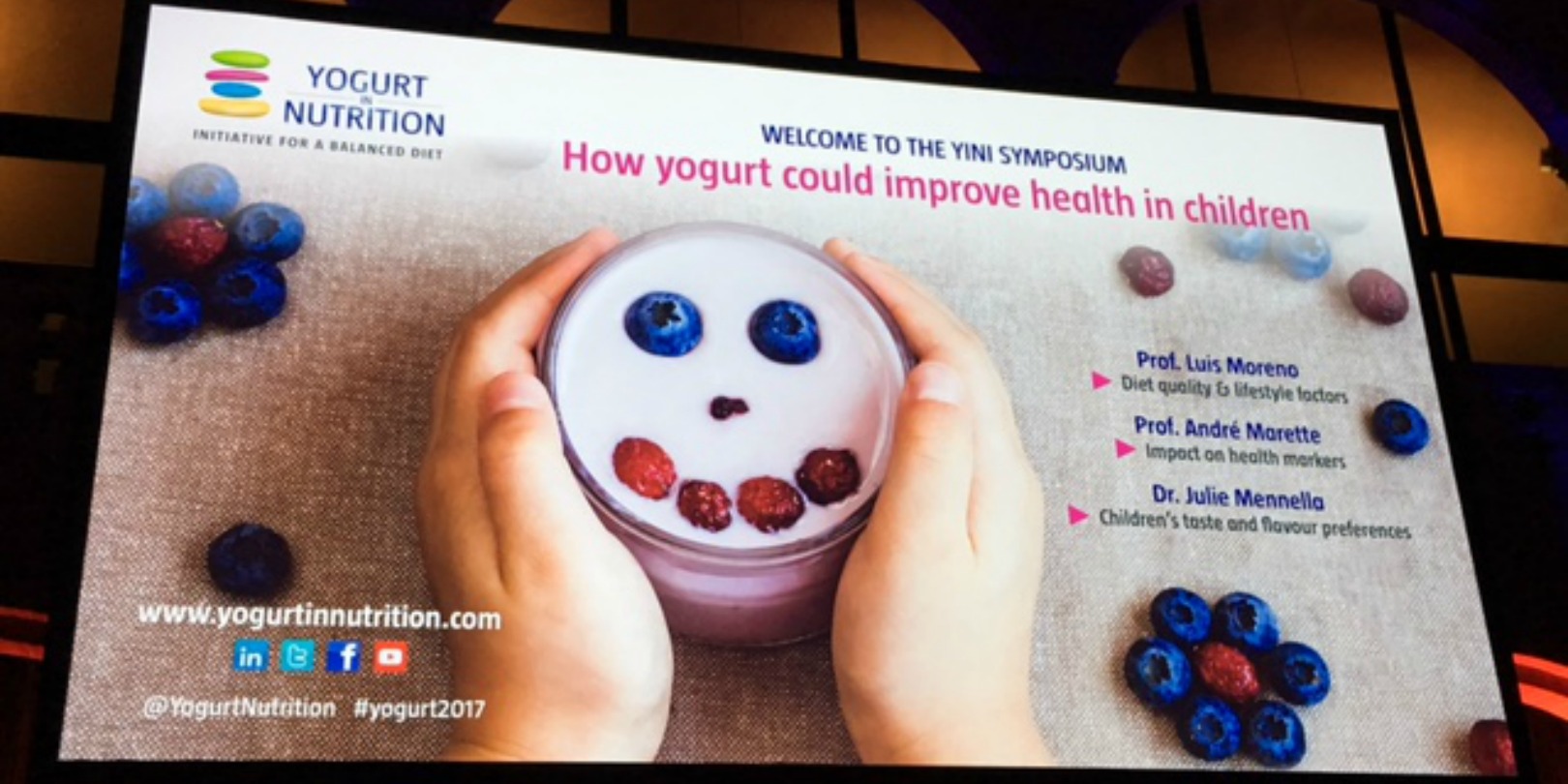23 Mar 2017
•
1 min read
YINI Symposium at Nutrition & Growth 2017: photo gallery

Related posts
Table of contents


Yogurt is a healthy diet element
The percentage of children getting enough calcium dramatically decreases after age two. Vitamin D and potassium intakes are low among children 2-11—both are often found in yogurt. The child’s bones grow quickly, and the calcium and protein found in yogurt are essential to children’s bone health. There is an evidence that children and adolescents who consume yogurt regularly (at least once a week) have a healthier diet than infrequent yogurt consumers.
Children with regular yogurt intake seem to eat more fruit and whole grains than the infrequent yogurt consumers (1). Young yogurt consumers have also a higher intakes of calcium, vitamin D, and potassium than non-yogurt consumers (4). Last but not least, yogurt is a dietary source of vitamin B, riboflavin, iodine, and phosphorus for children (3).
Sweetened foods are often preferred by children who are more likely to eat them as a result. The concern that sweetened dairy foods are contributing to exceed sugar intakes are apparently a misconception:
· In US children at the age of 6-17 year old,the intake of sweetened dairy products increases the number of dairy servings and has a positive impact on their diet quality, whereas sugary drinks and sweets have a negative impact (5,6).
· While more than 50% of total sugars and 66% of added sugars in children’s diets come from sweet products (cakes, sweets, etc.) and drinks, yogurt accounts for only 1–8% of total sugars and 4–9% of added sugar across Europe (7).
· Increased consumption of low sugar dairy foods, especially yogurt, at snack times, could increase the intake of important micronutrients without contributing to dietary excesses (8).
Here’s the best part: yogurt consumption can help children to get their enjoying snack, while staying within the daily calories limits. But that’s not all. Yogurt delivers a powerhouse of nutrients that help support their health in an appealing and readily available way, which is unmatched withmany other foods.
Yogurt may have important benefits for children’s health, including reducing obesity and cardiovascular risk.
Dairy foods intake is associated with a lower risk of childhood overweight/obesity (2, 9). Similar results are being found more specifically with yogurt consumption.
Furthermore frequent yogurt consumption (more than once a week) is associated with an improved insulin profile in children and teenagers: a lower fasting insulin level, lower insulin resistance, and higher insulin sensitivity.Yogurt consumption also protects against tooth erosion in children and adolescents, whereas carbonated drinks, fruit juices and sweets increase tooth erosion (10).
You don’t need to just scoop a blob of yogurt into a bowl and expect kids to eat it. Yogurt is extremely versatile and can be used in anything from salad dressing to homemade fruit pops. How can you make yogurt more fun for a child? Yogurt can be served with breakfast cereals, in whole grain pancakes, in smoothies, in marinades for meat and fish, in veggie dips, and many more recipes…

Yogurt consumption is associated with better metabolic profile in children, in particular those whose families are predisposed to obesity, and could therefore play a role in the prevention in childhood obesity. This was the message from Dr. Vicky Drapeau (Université Laval, Québec) to the YINI symposium “How yogurt could improve health in children”, which took place as part of 4th International Conference on Nutrition & Growth (Amsterdam, March 2-4, 2017).
There is a considerable amount of data showing that dairy products are linked with better body composition, metabolic health and a healthier lifestyle. Of all dairy products, yogurt is associated with the better dietary habits, and a number of its metabolic benefits have recently come to light. So, explained Dr. Drapeau, regular consumption of yogurt has been identified as a characteristic of a “prudent diet”, a dietary profile that, unlike the “Western diet”, is associated with better overall health, better glycemic control and notably a lower level of insulin, and less resistance to insulin.
However, there are not much data on children and adolescents, and until recently no study had considered genetic susceptibility to obesity. This latter issue is what Dr. Drapeau researched, as part of a YINI Grant, when she looked at the relation between yogurt consumption, weight and metabolic profile in children and adolescents genetically predisposed to obesity. Her research indicates that the consumption of yogurt is associated with a lower level of insulin, and that this association is particularly important for people predisposed to obesity. Another interesting discovery is that association with insulin levels is not influenced by body composition.
The hypothesis formulated in the research by Dr. Drapeau, namely that yogurt is associated with a better metabolic profile and a healthier weight profile, particularly for those children, who are genetically predisposed to obesity, is also confirmed by other elements. In a cohort of 198 children with a family history of obesity, monitored on a prospective basis, weight gain over 6 years proved to be lower among yogurt consumers than non-consumers. Dr. Drapeau concluded that even if intervention studies are required to confirm these results, this study suggests that yogurt consumption could constitute an interesting intervention strategy for tackling childhood obesity.

In children and adolescents, yogurt seems to be associated with a lower risk of obesity and insulin resistance, which are signs of early cardiometabolic protection, explained Prof. André Marette (Université Laval, Quebec), during the YINI symposium “How yogurt could improve health in children”, held during the 4th International Conference on Nutrition & Growth (Amsterdam, 2-4 March 2017).
Cardiometabolic disorders are partly caused by diet, but they could also be prevented by a better lifestyle. Dairy products and yogurt in particular are likely to reduce the risk of certain nutritional diseases. In their very recent systematic review and meta-analysis, Lu et al. showed that dairy products consumption was associated with a 38% reduced risk of childhood obesity. Moreover, they calculate that every additional serving of dairy per day lowers risk of childhood overweight and obesity by 13%.
In the American cohort NHANES 2005-2008 of children aged 8 to 18 years old, frequent yogurt consumers (more than once a week) showed significant differences in BMI as well as in adiposity, as indicated by waist size.
In adults, numerous studies suggest that yogurt consumption is associated with a reduced risk of diabetes. Marette recognised that there are fewer studies regarding children, but they indicate the same trend. So, in 2-18 years old children and adolescents, frequent yogurt consumers showed a more favorable fasting insulin level and a lower insulin resistance, as suggested by a lower homeostatic model assessment of insulin resistance and a higher quantitative insulin sensitivity check index. These data suggest that yogurt consumption in children and adolescents is associated with a healthier weight and insulin profile.
So, questioned Dr. Marette, what mechanisms could explain the healthy effects of yogurt? He suggested that the lactic cultures produce bioactive peptides and lipids that could have a number of beneficial effects. Bioactive peptides benefit digestion, intestinal microbiota, the vascular system, the nervous system, the immune system … to the extent that these peptides have serious potential in the fight against metabolic syndrome. Some lipids in yogurt, such as conjugated linoleic acid (CLA) and short-chain fatty acids, including butyric acid, appear to improve insulin sensitivity. Finally, the lactic cultures generate some fermentable oligosaccharides that have a prebiotic effect, which again represents preventive potential.
While prospective studies are still needed to better understand the long-term effects, yogurt constitutes a promising alternative to high-energy, low-nutrient snacks for children, concluded Marette.
Source: YINI Symposium “How yogurt could improve health in children” – 4th International Conference on Nutrition & Growth (Amsterdam, March 2-4, 2017)


More and more facts about positive effects of yogurt on children’s health. The goal of these « Best of » scientific studies is to bring together the current evidence about the associations between yogurt and overall diet quality, nutrient and sugar intake. In addition, associations between dairy and yogurt intakes on child health outcomes are reviewed.
There is accumulating data that adult yogurt consumers have better dietary intakes, reduced cardiometabolic risk factors and healthier lifestyles than non-consumers.. The current epidemic knowledge of childhood obesity shows that – associated metabolic syndrome, burgeoning risk of cardiovascular disease and diabetes upsurge among younger age groups. That represents a threat for individuals – but also places an enormous burden on health care resources in many countries. We summarise here the main key messages.
Frequent yogurt consumption may improve diet quality in children
Recent data from national surveys in many countries consistently reveal that current dietary intakes in children and teens are not sufficient for many key nutrients like: calcium, potassium, vitamin D.
Thus yogurt could be an appropriate solution as it is high-nutrient, low-energy food source that helps to meet the dietary requirements for calcium, potassium and vitamin D. Yogurt is also a source of high quality protein.
Too much sugar in yogurt? check the facts!
Many children and teenagers, like their parents, exceed the recommended intake for sugar (which should be <10% of total daily energy intake, according to the World Health Organization. There is a common misconception that sweetened yogurt consumption contributes to this problem. However, consumption of low-fat fruit flavored yogurt contributes in small proportion in children’s sugar intakes, and is associated with reduced saturated fat intake. Hence among children and adolescents, yogurt contributed only 1–8% of their intake of total sugars.
Yogurt and cardiometabolic profile
In addition, there is several evidence that children, who yogurt consumers, have a lower CVD risk factor and a lower risk of being overweight or obese in childhood, in comparaison with non-consumers. Yogurt consumption more than once a week was associated with improved insulin profiles as shown by lower levels of fasting insulin, reduced insulin resistance, and improved insulin sensitivity.
Further epidemiological studies and clinical trials are warranted to evaluate the effect of yogurt on modulation of the gut microbiota and the prevention of the risk of obesity and cardiometabolic diseases.
We hope that you consider this a useful resource for your clinical practice. Check it out!

A large amount of data on adults has shown that yogurt is associated with healthier dietary habits and a healthier lifestyle. Thus, it is a signature of a healthy diet and lifestyle for them. But what about children? While there are fewer data on children than on adults, they point towards the same conclusion, revealed Prof. Luis Moreno (University of Zaragoza, Spain). This could be explained by the fact that yogurt makes a significant contribution to the absorption of different nutrients, but also by the greater associations between the consumption of yogurt and lifestyle, continued Moreno.
Results from an American cohort of children aged 8 to 18 (NHANES 2003-2006) show that the consumption of yogurt is associated with a greater nutritional intake of calcium, vitamin D, and protein, as well as a reduced intake of fats, especially saturated fatty acids. For children aged 2-18, those who consumed yogurt more than once a week had a higher Healthy Eating Index score (a measure of the nutritional quality of their food) than occasional consumers. Those frequent yogurt consumers are also more likely to meet nutritional recommendations, in particular they consume also more fruits, wholegrain cereals and milk. In a British cohort of children aged between 4 months and 10 years old, yogurt is associated with a better range of micronutrients, especially vitamin B12, vitamin B2, calcium, iodine and phosphorus. Prof. Moreno also added that on the basis of data from several countries, yogurt only makes a slight contribution to the intake of added sugars.
Prof. Moreno presented data from children and adolescents from several European countries (HELENA and IDEFICS) on levels of physical activity and sedentary behaviour. For boys aged 2 to 9 years old, the levels of moderate and vigorous physical activity are higher with significant levels of yogurt consumption. For adolescents between 12.5 and 17.5 years old, yogurt consumption is significantly higher when there is greater physical activity and less sedentary behaviour (such as watching TV).
A more detailed analysis indicates that this effect is not observed for milk. For boys, the level of moderate to vigorous physical activity diminishes with greater cheese consumption. So, yogurt can be distinguished from other dairy products in that it is associated with a more active lifestyle.
Given that yogurt consumers have better nutritional intakes, healthier dietary habits, and tend to have a higher level of physical activity and less sedentary behaviour, Prof. Moreno concluded that yogurt consumption can in effect be considered a signature of a healthy diet and lifestyle for children too.
· Yogurt makes a significant contribution to the coverage of numerous nutrients
· Children who consume yogurt regularly have better nutritional intakes than those who consume it occasionally
· In adolescents, yogurt consumption is associated with a higher level of physical activity and less sedentary behaviour
· Yogurt appears to be a signature of a healthy diet and lifestyle for children too
To learn more, read the original article.


The symposium, developed by the Yogurt in Nutrition Initiative for a Balanced Diet, ended with a very positive conclusion. The event, chaired by Sharon Donovan (University of Illinois, U.S.A.) and Olivier Goulet (Hôpital Necker-Enfants Malades, France), brought together many participants and led to numerous debates around presentations by Professor Luis Moreno (University of Zaragoza, Spain), Professor André Marette (Université Laval, Canada), Dr. Vicky Drapeau (Université Laval, Canada) and Dr. Julie Mennella (Monell Chemical Senses Center, U.S.A.). What were the main take-home messages?
An accumulation of scientific evidence in recent years has proven that the consumption of yogurt is probably the signature of a healthy lifestyle and diet for adults. As yet, such a statement cannot be made for children, but some studies are pointing in this direction, in the words of Professor Luis Moreno. The results from American and British cohorts of children aged 2 to 18 underline the fact that yogurt consumption is associated with higher nutritional intakes (calcium, vitamin D, vitamin B2, iodine, phosphorus, proteins) and better compliance with nutritional recommendations, especially concerning fruit, wholegrain cereals and milk. Recent studies (HELENA and IDEFICS) carried out in several European countries also associate yogurt consumption with higher levels of physical activity and less frequent sedentary activities (notably, looking at a screen). These effects have not been observed for other dairy products, and thus tend to confirm observations already made among adults. Read here the full report on his talk.
Excess weight and obesity are affecting more and more people, both adults and children. Among the latter, obesity has practically doubled in fifteen years. Can we assert that dairy products are partly responsible for this? In fact, studies on the subject instead highlight the protection dairy products provide, Prof. André Marette noted. Dairy products have a significant association with a reduced risk of excess weight and obesity for both children and adolescents. More specifically, yogurt consumption among children is associated with lower BMIs, smaller waist sizes and less body fat. Yet, while the positive impact of yogurt on the prevention of Type 2 diabetes is well documented for adults and older people, there is currently a lack of data concerning children. Nevertheless, certain indicators support the theory: regular yogurt consumption is associated with a more favorable level of plasma insulin and a better sensitivity to insulin, so a reduced risk of insulin resistance. According to Prof. Marette, this makes yogurt one of the best snack options for the very young. Check out his presentation!
Besides primary prevention, yogurt could also help with the secondary prevention of obesity. That is what Dr. Vicky Drapeau is currently studying, as part of her YINI research grant. Her work should allow us to better understand the relationship between yogurt consumption, body weight and metabolic profile among children with a familial predisposition to obesity. The definitive results to the research are expected later in 2017, but Dr. Drapeau has already revealed some preliminary indications in a sneak preview. These show that yogurt consumption is associated with a better metabolic profile among children and adolescents, and that this protective effect is more marked where there is a family history of obesity. The results need to be confirmed, but they indicate that this dairy product can already be considered as a possible interesting avenue of intervention. Learn more!
A preference for sweet flavors (and surprisingly also acidic ones) among children, and an aversion to bitterness, is a reflection of basic biological needs, according to research on the subject presented by Dr. Julie Mennella. Indeed, all children are born with a marked preference for sweet flavors. They prefer sweeter flavors than adults, but this preference for sugar diminishes at the end of adolescence, which coincides with the end of physical growth and the emergence of taste preferences comparable to those of adults. Although acidic flavors have been studied less, the same tendencies can be observed: the reaction of children to such flavors is immediate, from birth, and children also favor more acidic flavors than adults. Dr. Mennella indicated that these preferences could play tricks in our modern dietary environment, in particular leading to an excessive consumption of sugar. That is why it is important to educate about taste, with food low in calories and high in nutrients such as yogurt, from a very young age.

 Dr. Julie A. Mennella, Biopsychologist from the Monell Chemical Senses Center in the United States, will focus on the taste development & flavour preferences in children: “Sweet and Sour Tastes – From Inborn Responses to Contextual Learning in Foods.”
Dr. Julie A. Mennella, Biopsychologist from the Monell Chemical Senses Center in the United States, will focus on the taste development & flavour preferences in children: “Sweet and Sour Tastes – From Inborn Responses to Contextual Learning in Foods.”
She obtained a Ph.D. from the Department of Behavioral Sciences at The University of Chicago in Chicago, IL. She joined the faculty at the Monell Chemical Senses Center in Philadelphia, PA in 1990 where she is now a Member. Her major research interests include investigating the timing of sensitive periods in human flavor learning and growth; uncovering how children are living in different taste worlds than adults and their vulnerabilities to the current food environment as well as medication adherence; and the development of psychophysical tools to study individual variation in taste and avor perception.
In addition to her research, she founded a program at Monell Center that encourages under-represented minority high school and undergraduate students to pursue careers in science and medicine. Dr. Mennella has held a number of leadership positions in professional scientific societies and participated in working groups at the National Institutes of Health and other international scientific and health organizations.
She is the recipient of several grants from the National Institute of Deafness and Other Communication Disorders and the Eunice Kennedy Shriver National Institute of Child Health and Human Development; the author or co-author of numerous peer-reviewed research papers and an internationally recognized speaker on the ontogeny of avor preferences and its implications for health and nutritional programming.

